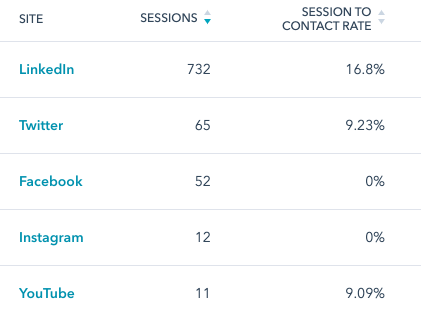Marketing at an early-stage, pre-product company looks a lot different than it does at more mature company with a product. When no one is selling anything yet, marketing's role is to build a foundation for the company's future efforts - launching the first product, recruiting employees, attracting customers.
Pre-product marketers can't be measured on revenue impact, or even inbound lead contribution. There is no revenue, and no one's really working leads. But it is still marketing, even if it looks a little different.
That's where Gradient Works is right now. Our company is just getting started, and we're pre-product (though not for much longer!). So, what were our 2020 marketing goals, when we didn't have a product to sell? We focused on three areas this year.
- Begin to build an audience
- Learn about our future customers
- Test marketing tactics
We started our Up and to the Right newsletter in late August, so it’s been about four months since we started "marketing." Since then, we’ve been blogging regularly, and hosting an expert Q&A that we distribute in video and audio podcast formats. We share and engage on LinkedIn, and sometimes update Twitter.
While we're working to establish our voice and build up an audience, we're also trying to understand what our future customers want to read about. What topics are they interested in, what positioning resonates, what headlines draw them in? We also need to test out channels and formats. How do they want to consume our content? We've actually learned quite a bit from these four months. And so, in the spirit of openness and transparency, here are a few of the lessons we've learned so far about pre-product marketing, supported with data when we have it.
Building an audience from scratch is hard.
When you're marketing to an existing audience, you forget how hard it is to find that audience in the first place. Yeah, you spend a lot of time trying to grow that audience, but at least you've got something to build from. When you start a new company, have you no audience. Literally no one cares.
So you have to start from scratch - convince former coworkers, network contacts, even your friends and family to just pay attention for a minute. To do that with Gradient Works, we've depended a lot so far on amplification from our personal networks.
Our expert Q&A guests have helped here, as well - tapping into other existing audiences helps grow ours. We’ve also written some content for other sites, like Sales Hacker and Revgenius. All of these start to grow our surface area, and we reach more people every week.
We've been aiming for 6% audience growth every week, across our newsletter list and the social channels we care about (more on that in a minute). Some weeks we reach that goal. Some weeks we don't. That's been harder to achieve than expected.
Producing regular, high quality content is harder.
If finding an audience is hard, creating regular content that is deserving of that audience is even harder. We’re not writing just to put some words on our blog; we’re writing to say something about our point of view. That includes posts like these:
- Your reps should own accounts, not leads
- Your customer experience can and should be better
- We should stop using geographic sales territories
This kind of content takes time. You can’t just magic up a meaningful post in 15 minutes. It takes hours of outlining, writing, editing, and rewriting to produce content like this. It goes faster when you're inspired, but you can't force inspiration. Some weeks it's really tough to complete both the quality and quantity of content we're trying to produce.
Personal, specific content performs well.
Our top posts (in terms of views) are the ones about our personal experiences. That includes posts like:
- The kind of company we want Gradient Works to be
- 4 things I’ve learned after the first week of my internship
Both of these posts focus on the individuals behind the company - our founders, our intern. This makes sense, since we're more likely to generate clicks from posting these to our individual social profiles. Friends, family, followers will all click on a post like these.
But in terms of relevant engagement, our sales and marketing-focused content performs best when we get into deeper-level topics. Not just "how to manage a sales team" but something like "how to move your remote B2B sales team away from geographic territories." These get the most views and the most newsletter signups (which is the closest thing we have to a conversion right now... so if you're reading this, you should sign up). This content has to be specific, detailed, and beyond beginner or surface level.
LinkedIn is the right social channel for B2B content right now.
We use Hubspot for our email newsletter and website CMS, so we can clearly see how people engage with our emails and blog posts. And when it comes to social media, LinkedIn generates more inbound traffic than any other social site by far. We're most active (individually and as a company) on LinkedIn, but we've shared content across Twitter, Instagram and YouTube, and LinkedIn is just the right place to be for B2B content.

Long-form content has a place.
Pith and brevity are important. They’re the backbone of good marketing. But sometimes you need more space to really get to the heart of a topic. Long-form content does have a place in a marketing program, as long as you make it worth the time it takes to consume.
We started out thinking we'd try to keep our expert Q&A videos to less than 10 minutes. That proved nearly impossible though - it's hard to get to something truly unique or insightful in a 10-minute conversation (or maybe we're just long-winded). So we started letting the conversations go as long as they made sense, sometimes as long as 30 or 40 minutes. And while our average video watch duration is around 4 minutes, 20-25% of viewers watch the entire video, every time. It doesn't seem to matter if the video is 10 minutes or 30 minutes.
It also helps to make long-form content in a format that's well-suited for that kind of length. We convert all our video chats to audio-only podcasts, so our audience can find and listen whenever it's convenient (and at a faster speed if they want). That's been successful, and increases views (and/or listens) by 25% or more for every video.
Content saturation is real.
There is so much content out there. Like so, so, so much content. Everyone has a content marketing program or a Substack, and they are prolific. Like all of you, we want to find ways to stand out amidst all the other noise. We look for new topics to explore, or new approaches to older topics. We're finding our voice, learning what distinguishes us from our future competitors and a bevy of LinkedIn thoughtfluencers. This will be a process of continual improvement, using data from our past content to inform strategy on what breaks through the noise and what doesn't. Our newsletter audience has been great for providing useful qualitative feedback on the content we share, and we read all of it.
Our audience is still small, but highly engaged.
Since we are still so early in terms of audience building, we have to look at more than just our audience size. It's a small group, but they are extremely engaged. We expected high engagement at first, since we were new, a curiosity. But we also expected those initial high engagement rates to fall down to more normal levels after a few weeks.
And yes, newsletter engagement has dropped since our first few issues. But not nearly as much as we expected. Our average email open rate for Q4 is 43%, and our total clickthrough rate is around 10% (with a click-to-open rate between 20 and 25%). These numbers are considerably higher than industry benchmarks, and it gets harder to explain with "oh well we like these people so we'll open their email" after 16 issues. The content must have some value to our audience.
The hard part is just coming up
We're preparing to launch our first product in the next few months. That means the real work of marketing is only just beginning, and the next four months will put these early lessons to the test. As always, we'll share what we learn.




